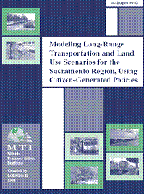- 408-924-7560
- mineta-institute@sjsu.edu
- Donate
Modeling Long-Range Transportation and Land Use Scenarios for the Sacramento Region, Using Citizen-Generated Policies
The Sacramento, California region engaged in an innovative long-range visioning process during 2004 and 2005 in which the regional transportation planning agency defined and modeled several 50-year growth scenarios. The authors of this report worked with environmental and social equity community groups to define policies that would reduce emissions, serve lower-income travelers better, and preserve habitats and agricultural lands in the region. The community groups rejected the new freeways planned for the region, as well as the substantial freeway widenings for HOV lanes. In addition, they defined a more ambitious transit system, involving new bus rapid transit lines and shorter headways for all rail and bus service. This transit-only plan was modeled by itself, and with a land use policy for an urban growth boundary and a pricing plan for higher fuel taxes and parking charges for work trips. Using a new version of the MEPLAN model to simulate these scenarios over 50 years, the authors describe their findings regarding total travel, mode shares, congestion, emissions, land use changes, and economic welfare of travelers.
ROBERT A. JOHNSTON
Robert A. Johnston is a professor in the Department of Environmental Science and Policy at the University of California at Davis, where he also serves as a faculty researcher at UCD’s Institute of Transportation Studies. Current consulting involves the evaluation of regional travel demand models and land use models for public and private clients and reviews of environmental assessments of large projects. He has been an expert witness in several NEPA lawsuits. Johnston’s current research projects include the evaluation of transportation policies using advanced regional travel demand models. He also is performing research using an integrated urban model of the Sacramento region. Another recent project was a comparison of three urban models on the same datasets for that region. Johnston’s GIS-based urban growth model is being applied to several counties in California for the California DOT.
SHENGYI GAO
Shengyi Gao is a PhD candidate in the Transportation Technology and Policy Graduate Group at the University of California, Davis. His research interests include the relationships between land use and transportation, transportation equity, urban growth modeling, and application of geographic information system technology in transportation and land use planning.
MICHAEL J. CLAY
Michael J. Clay is a PhD candidate in the Transportation Technology and Policy Graduate Group at the University of California, Davis. He has published work on travel behavior, travel demand management, and project impact assessment. His research interests include transportation planning and policy, integrated land use and transportation modeling, urban policy analysis, and land use planning.
-
Contact Us
San José State University One Washington Square, San Jose, CA 95192 Phone: 408-924-7560 Email: mineta-institute@sjsu.edu






